The 2007 1080p RPTV Face Off Toshiba 62MX196 DLP HDTV
Balanced in the middle.
In last year's RPTV Face Off, the Toshiba and JVC TVs tied for second place. This year, the Toshiba missed out on that same tie by only one point. Other TVs in this Face Off excelled strongly in certain categories and not in others. The Toshiba, on the other hand, did well in most categories, except for one, that is.
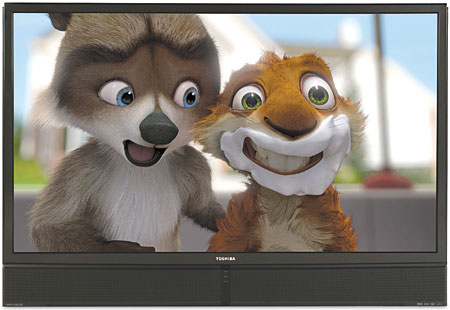
The comments for the Toshiba generally remarked on its balance. The color accuracy, while not as good as some of the other displays', was better than average. The Toshiba's overall contrast ratio was the second lowest, but its ANSI contrast ratio was the second highest. The amount of detail was better than some but not as good as others. And there didn't seem to be too much noise in the image with any of the sources we demoed.
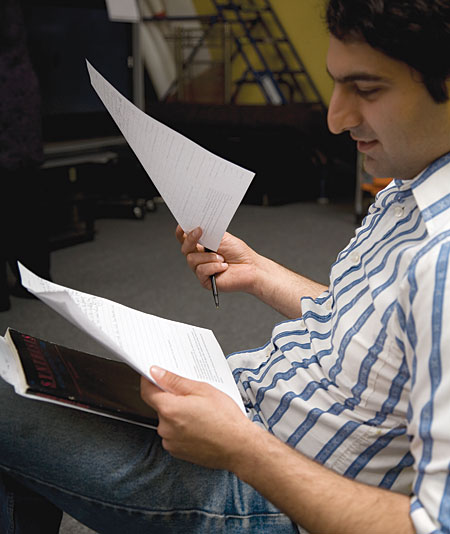
Processing was fairly average. The 62MX196 picked up the 3:2 sequence with 480i on both the Gladiator clip and the Silicon Optix disc. The waving flag from Silicon Optix had some jagged edges, but it wasn't too bad. While the 62MX196 deinterlaced 1080i/30 correctly, it wasn't able to pick up the 3:2 sequence (like most of the displays here). As you'll see in a moment, this was more of a pressing issue here.
 While the value of this TV may seem high, you'll need to add $300 to its price for a good calibration. Out of the box, the 62MX196 is wickedly cool, like every other Toshiba display we've reviewed recently. I understand why a manufacturer would want their TVs to be set to the coolest color temperature out of the box, but why not at least give us enthusiasts the ability to drop to normal levels if we want? Nearly every other TV manufacturer does. Toshiba's stubbornness not to do so is a little odd. With an ISF calibration, though, you can get it to track D6500 pretty well. This might be disappointing to those who don't like forking over more dough on a brand-new TV, but, because it can be calibrated, this really only adversely affects the TV's value rating. Unfortunately, color temperature isn't the only place where the Toshiba stands out—in a bad way.
While the value of this TV may seem high, you'll need to add $300 to its price for a good calibration. Out of the box, the 62MX196 is wickedly cool, like every other Toshiba display we've reviewed recently. I understand why a manufacturer would want their TVs to be set to the coolest color temperature out of the box, but why not at least give us enthusiasts the ability to drop to normal levels if we want? Nearly every other TV manufacturer does. Toshiba's stubbornness not to do so is a little odd. With an ISF calibration, though, you can get it to track D6500 pretty well. This might be disappointing to those who don't like forking over more dough on a brand-new TV, but, because it can be calibrated, this really only adversely affects the TV's value rating. Unfortunately, color temperature isn't the only place where the Toshiba stands out—in a bad way.
This is the only TV in this year's Face Off that doesn't accept 1080p on any input. Last year, such ability was a rarity, but now it is commonplace. This exclusion is notable and disappointing. Other TVs in Toshiba's line accept 1080p, but not the 1080p RPTVs. Now that we have a real 1080p/60 source (PlayStation 3), this lack sullies an otherwise decent TV. Furthermore, the 62MX196 can't pick up and process the 3:2 sequence from 1080i correctly. The lack of a 1080p input caused Adrienne to drop the Toshiba from its original second-place finish in her rankings to third, securing its position from what otherwise would have been a tie for second place. It's interesting to note, in fact, that every one of our panelists ranked this TV third. That's a surprising amount of agreement among five people.
So, on a performance level, the 62MX196 does a lot of things well but doesn't excel in any one area. With the lack of a 1080p input, it wasn't able to move any higher.
Highlights
• Well balanced
• Not too much noise in images
At A Glance: Toshiba 62MX196 DLP HDTV
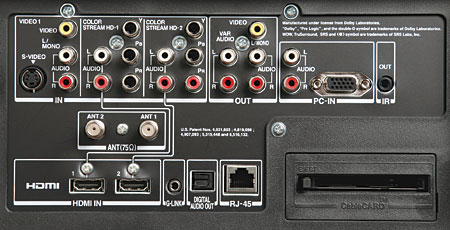
Connections
Inputs:
Video: HDMI (2), component video (2), S-video (2, shared), composite video (2, shared)
Audio: None
Outputs:
Video: Composite video (1)
Audio: Stereo Analog (1), Optical (1)
Additional: CableCARD (1), PC-RGB (1), G-Link, RJ-45 (1)
Features
Type: DLP
Screen Size (Diagonal): 62
Native Resolution: 1080p Lamp Life: 6,000–8,000 hours
Dimensions (H x W x D, inches): 39.25 x 57.06 x 18.75
Weight (pounds): 103
Price: $3,100
Ratings: Toshiba 62MX196 DLP HDTV
Build Quality: 86
Value: 89
Features: 88
Performance: 92
Ergonomics: 90
Overall Rating: 90
General Information
62MX196 DLP HDTV, $3,100
Toshiba America Consumer Products
(800) 631-3811
www.tacp.toshiba.com
Dealer Locator Code TOS
HT Labs Measures: Toshiba 62MX196 DLP HDTV
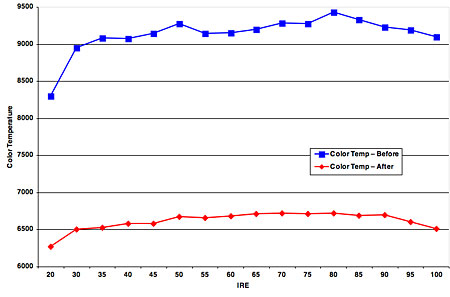
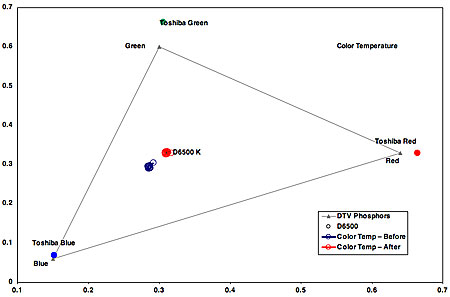
Full-On/Full-Off Contrast Ratio—2,959:1; ANSI Contrast Ratio—401:1
Measured Resolution with the Leader
LT-446:
480: 480 (per picture height)
720p: 690 (pph)
1080i: 1,060 (pph)
DC Restoration (poor, average, good, excellent): Excellent
Color Decoder (poor, average, good, excellent): Average (Adjustable to Good)
Measured Color Points:
Red Color Point: x=0.664, y=0.330
Green Color Point: x=0.306, y=0.664
Blue Color Point: x=0.152, y=0.069
The left chart shows the 62MX196's gray scale relative to its color temperature at various levels of intensity, or brightness (20 IRE is dark gray; 100 IRE is bright white). The gray scale as set by the factory, in the Low color-temperature mode, measures extremely cool. After making adjustments using the Photo Research PR-650, the gray scale measures a little warm with the darkest images, a little cool with midtones, and back to nearly D6500, the accurate color temperature, with the brightest images.
The right chart shows the gray scale (or color temperature) relative to the color points of the display's red, green, and blue color-filter-wheel segments. These are somewhat off those specified by SMPTE. Red is oversaturated. Blue is very slightly undersaturated and very slightly greenish-blue. Green is oversaturated and slightly yellowish-green.
After calibration, and using a full-field 100-IRE white (65.09 foot-lamberts) and a full-field 0-IRE black (0.022 ft-L), the contrast ratio was 2,959:1. Using a 16-box checkerboard pattern (ANSI contrast), the contrast ratio was 401:1. The best contrast ratio was achieved in the Low Power mode. The brightest image was achieved in the High Bright setting and produced 89.3 ft-L with a 100-IRE white and 0.031 on a 0-IRE black (2,881:1).—GM
- Log in or register to post comments




































































